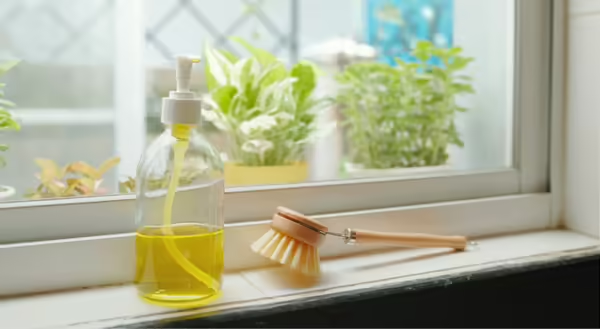
A little spring cleaning and decluttering can be hard work, but the end result is worth it. According to National Science Foundation (NSF), the kitchen is said to be the germiest room in the house. Everyday tasks, such as washing dishes and prepping food can actually spread bacteria if not done correctly.
Kitchen sponges, dish rags and scrub brushes, if not properly washed and sanitized between uses, can be a hot spot for bacteria. Sponges especially hang on to moisture, which aids in bacterial growth. This breeding ground could potentially spread harmful bacteria, doing more harm than good. Scrub brushes are more of a hygienic option because they dry faster and therefore, harmful bacteria die faster. However, no matter whether you use a sponge, dish rag or scrub brush to wash dishes, it is recommended that you replace it with a clean one every day. Also, consider how you and your household (or workplace) are using it. Is it only being used to wash dishes, or is it also being used to clean up spills or brush off debris before putting the dish in the dishwasher? Never use a sponge, dish cloth or scrub brush for cleaning dishes after it’s been used to clean spills or brush off food without cleaning and sanitizing it first.
According to the USDA, microwaving sponges kills 99.99999 percent of bacteria while dishwashing kills 99.9998. Wash scrub brushes in the dishwasher but consider microwaving sponges. Only microwave sponges that do not have any metallic content. Soak the entire sponge in water to create steam and avoid risk of fire, place it in a microwave-safe bowl and microwave for 1 minute. The sponge will be very hot so take safety measures when removing it. Dishcloths and rags should be washed using the hot cycle of your washing machine.
The kitchen sink is another hot spot where microorganisms are found. Never set produce or other food in the sink without cleaning and sanitizing it first or the food may become contaminated. Clean your sink with warm, soapy water and wipe with disposable paper towels. Spray or wipe the sink using a commercial sanitizer, sanitizing wipe, or make your own by mixing 1 tablespoon of bleach with 1 gallon of water. Let it air dry. Springtime is a great time to think about and possibly change our cleaning practices!
Sources:
NSF. Clean the germiest home items.
Nichols, J. (2014). Sanitizing kitchen sponges. Michigan State University.
About the Author
Jenna Smith is a Nutrition and Wellness Educator with University of Illinois Extension, serving Livingston, McLean, and Woodford Counties. Smith uses her experience as a registered dietitian nutritionist to deliver impactful information and cutting-edge programs to Livingston, McLean, and Woodford Counties and beyond.